Who am I? And how do I express myself, show myself, as a dancer?
This question has kept me (Deirdre) occupied for some time now. I feel like I have reached this point in my dance career where I can learn new moves, new variations and new ways of styling (and I will, for sure), but the one thing that is really going to make a difference for me, is finding a way to be me. To find a way to express myself.
Easier said than done. Because how can you express yourself as a dancer? When I saw this video from Amy and Alex on their Instagram about body awareness and followers empowerment, I knew there was in interesting story there. A piece of the puzzle that I needed.
And so in this interview, Amy Lu, International Swing Dance teacher revered for her authenticity and creative flair, and I will be talking about self-expression in (Swing) dance.
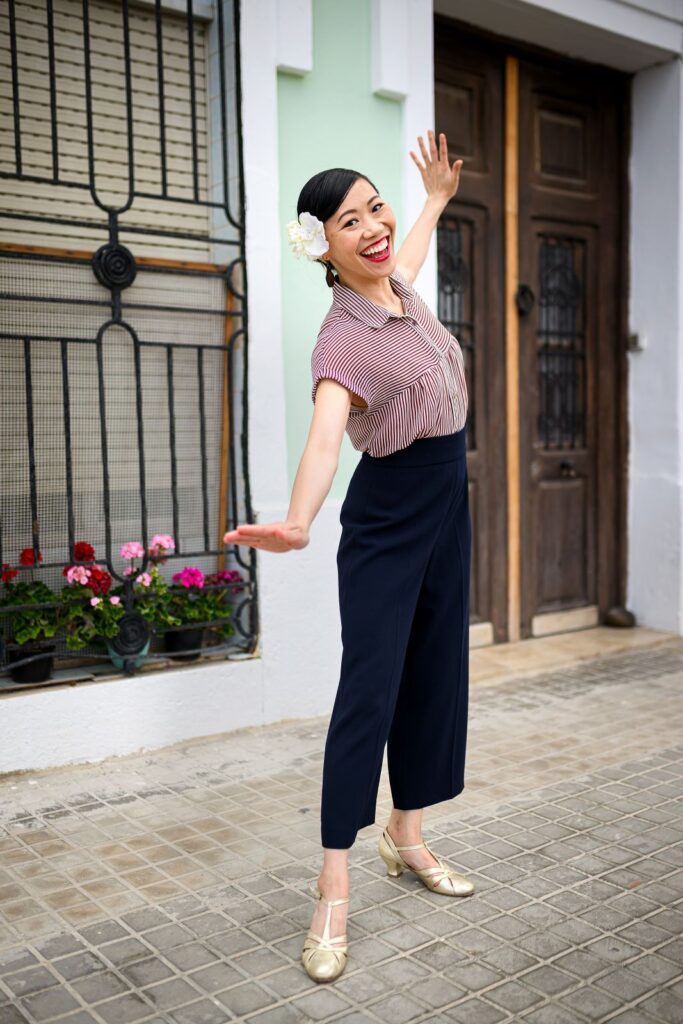
From her early days steeped in Visual Arts to her unexpected journey as a Maths teacher using artistic thinking processes, Amy’s path has been anything but conventional. “I was always interested in expressing myself, whether it’s through words or through imagery. And it wasn’t until later on that I went into the movement arts, which is where the dance came in,” Amy reflects on her transition into the world of dance. This holistic background sets the stage for her unique approach to self-expression and empowerment on the dance floor.
“For me, self-expression was always a part of who I was and where I came from. And so, I feel like it’s not something I could just let go of,” Amy shares, highlighting the intrinsic role of personal history in shaping our expressive voice.
The concept of self-expression in dance transcends mere physical movement; it represents a journey into one’s deepest emotional recesses, a form of vulnerability and bravery that goes far beyond executing steps to a musical beat. It’s about peeling back the layers of one’s guarded self, showcasing raw feelings and authenticity, potentially for the world to see, or perhaps, more importantly, for oneself to understand and accept without an ounce of judgment or reservation. As Amy explains, “It’s allowing for this to come out and you’re basically allowing yourself to show who you are to the world… you are bringing out a part of you.”
“The idea of personal expression is really the idea that you’re digging really into yourself without any judgment,” Amy underscores. This introspective exploration, demanding as it is liberating, challenges dancers to confront their insecurities, their fears, and their joy, translating them into a language of movement that’s unique to each individual.
Discussing the nuances between followers’ footwork, styling, back leading, and empowerment, Amy unravels the complex tapestry that makes up a dancer’s repertoire. Each aspect, from physical movements to the mindset with which a dancer enters a partnership, contributes to the overall expression.
“The moment you add the word ‘empowerment,’ that means the follower is saying, ‘I’m going to do something, and I’m going to be very specific about it… I’m here, I’m present, listen to me‘”
While followers’ styling and variations are more about the physicality of the moves, empowerment is the attitude, the bold statement that a dancer makes within the partnership. “I like to use the word ‘empowerment’ because it means that the follower carries themselves in a certain way in which they bring themselves and they take some space in the dance,” Amy points out.
This notion of ‘taking space’ might initially be intimidating for some dancers, as there’s a fine line between contributing to the dance and overshadowing the partner. However, Amy advocates for a balanced partnership where space and weight are shared and negotiated, ensuring a harmonious dance experience.
“In a partnership, there’s always a negotiation of the space. You’re all working together; you’re a balance,” she notes, advocating for a mutual give-and-take between partners.
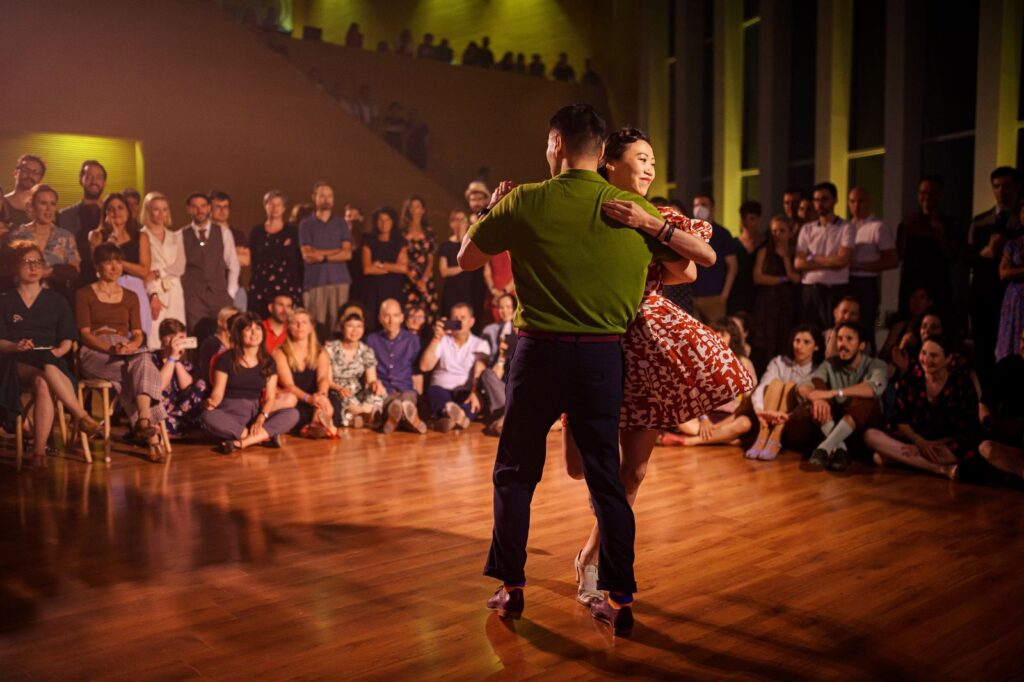
Was self-expression always an integral part of Amy’s swing dancing journey, or did it evolve over time? “When I hear this music, it just automatically brings a part of me out, and I can’t help but move. I feel that this is the type of music that I identify with,” she recalls. This love for the music and the movement helped shape her individuality on the dance floor from the very beginning.
However, self-expression isn’t static; it grows as dancers delve deeper into understanding who they are and how they can manifest that in their art. It’s more than just mastering the steps; it’s about the ongoing quest to convey one’s identity through dance.
“For me, it’s not so much anymore about learning new moves… For me, it’s a challenge of who I am as a dancer or who I really am and how can I express that in my dancing,” Deirdre interjects, echoing the sentiments of many in their dance journey.
“I finally made it. I’m light,” Deirdre recalls her pride during a dance with an international teacher, only to question moments later, “But is it a good thing?” This dilemma touches on a critical aspect of partner dancing — the engagement between lightness and heaviness. It’s not merely about physical weight but the essence one brings into their movement and connection.
The journey begins with understanding the dynamics of lightness and weight. One might strive to become a ‘light dancer,’ easy to guide, and move around the dance floor. However, an interesting conundrum presents itself when achieving this state of lightness. Does it diminish the presence or significance of the dancer? Is there such a thing as being “too light,” thereby reducing the necessary tension or connection required in partner dance?
Amy explains this balance with eloquence, relating it to her life philosophy and partnership. “It’s all about that partnership, that communication between the individuals…developing a sensitivity of feeling each other.” In dance, as in her marriage, there’s a give-and-take dynamic, an interplay of support that is tangible even in the way partners influence each other’s weight during a dance.
“The concept of balance,” Amy remarks, pointing to the tattoo on her rib as a constant reminder, is central to this understanding. Through dance workshops and her professional training, she learned that one has to be “a little bit heavy to create lightness.”
In contemporary dance, especially in genres like Contact Improvisation, being ‘too light’ or merely hanging on your partner doesn’t suffice. Engaging your muscles, being ‘awake’ in your body, creates the necessary tension that makes dance, quite literally, a balanced act.
“Our body’s more engaged,” Amy notes, emphasizing the role of mutual adjustment in partnership. “If our partner’s giving 50, we’re giving 50. If they need 75, I’m giving 75.” This responsiveness is not about mirroring but rather harmonizing with your partner’s energy, requiring stillness and presence of mind.
“It’s about…that observation of feeling out your partner,” she adds, an aspect often overlooked when dancers are mentally scattered, stressed, or simply out of sync with their bodies.
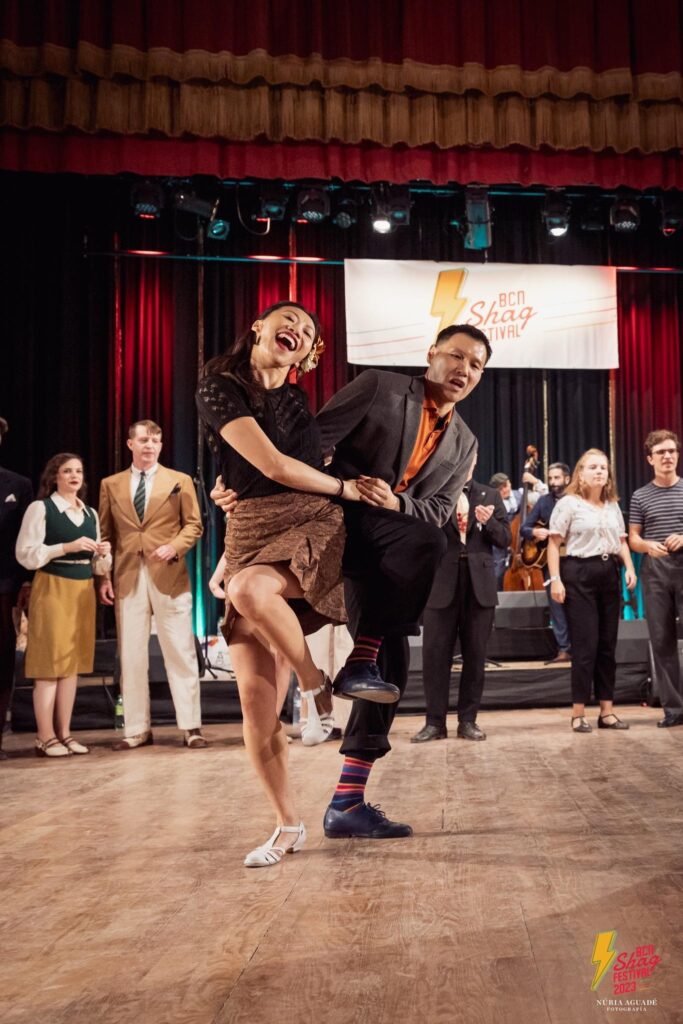
This philosophy extends into Alex and Amy’s ‘Follower’s Empowerment’ course, a transformative experience encouraging followers to assert their voice. “A lot of what I do in my partnership with Alex is that I allow myself to take the space, and he learns to respond to me,” she shares, underlining the reciprocal nature of this dance dynamic.
The course, inspired by Amy’s work with Julie Martin at the Sacred Dance Retreat, navigates various techniques, from simple rhythm changes to more pronounced, ‘heavier’ assertions. “When it gets to be a little more dense, a little more heavy, that’s where it gets intimidating because we’re really asking you to take more space,” Amy admits.
One key aspect taught in the course is resistance — not as defiance but as an expressive tool. By altering the speed, adding a delay, or even introducing a different rhythm, followers create a space that leaders must respond to, thereby turning traditional roles into a true dialogue.
“It means that the leaders now actually have to respond and come into the role of being a listener,” Amy explains.
So while followers learn to assert their presence, leaders, too, need to adapt. They should be ready not just to lead, but also to listen and respond. This responsiveness can lead to unexpected, creative outcomes, making the dance more enriching. However, this shift isn’t always easy. Leaders accustomed to traditional dynamics may find these new and assertive followers initially disruptive.
Therefore, in dance classes we should gradually incorporate these aspects, ensuring leaders understand and appreciate the followers’ inputs. It starts with the simple acknowledgment that both partners contribute to the dance, creating a shared space that respects and celebrates each individual’s input.
In the end, it circles back to the essence of partner dance: sharing space. “It’s not about ‘it’s all about me,’” Amy concludes. “When you’re sharing space, it’s about seeing the other person but also allowing them to see you.”
When asked about the significance of empowerment in dance, Amy reflects on her personal journey. “I just felt like I had such a tiny voice and it just felt like I couldn’t really be myself. Like I was really just kind of doing things for someone else,” she shares, highlighting a common feeling of restraint many dancers navigate. This realization isn’t confined to dancing alone but extends to professional and personal life, where individuals often find themselves compromising their identities.
“For me, this empowerment piece is so important because now you’re starting to say, look, I’m going to start taking a little bit of space for me. I’m going to start sharing who I am,” Amy asserts, underlining the transformation from restriction to self-expression. This shift isn’t just about asserting oneself but also about balancing personal expression within a partnership, recognizing dance as a collaborative effort.
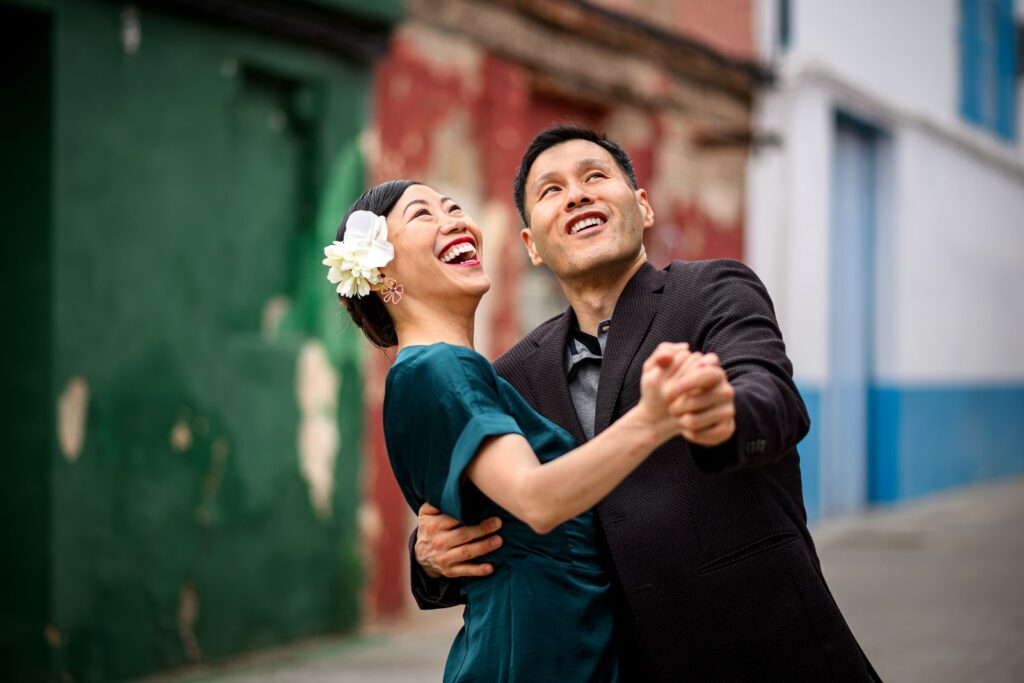
Amy recounts a pivotal moment during the Snowball event in December 2022, which became a metaphor for her journey. Faced with a split-second decision to follow the expected move or make a bold statement, she chose the latter, kicking her leg towards the audience. “I had to make a decision, and I went with a feeling, a gut feeling, and next thing I know, I kick towards the camera… and I just get this big audience roar,” she recalls, her decision resonating with the crowd and becoming a defining moment of authenticity for her.
The response was overwhelmingly positive, with feedback continuing even at events like the Barcelona Shag Weekend almost a year later. Amy’s story reinforces the idea that embracing one’s authentic self, though often daunting, can be incredibly rewarding. “Is it better to be too much than too little?” she reflects, acknowledging the fears associated with ‘being too much.’ Her conclusion is powerful: “I’d rather be a bit more than nothing at all, because there are things that need to be said, and movements need to happen, and we can’t be afraid anymore.“
Amy suggests several strategies for dancers seeking to express themselves more authentically in their dancing.
Key Tip 1: Engage in regular self-reflection and inner work, utilizing tools like journaling, therapy, or meditation. Allow yourself emotional release.
“One of the biggest things that I’ve done to get to this place, where I’m more comfortable with myself, is a lot of inner work,” Amy shares candidly. She rejects the notion of perfection, a sentiment echoed throughout the dance community, and instead, champions the mantra: “Practice makes progress.”
This perspective shift is vital. As Amy reflects, “You can only make progress in improving yourself,” suggesting a journey rather than a destination. This holistic approach to dance underscores the importance of mental and emotional health, resonating deeply within the community.
In the pursuit of self-improvement, Amy, a certified 500-hour yoga instructor, advocates for methods such as self-reflection, journaling, and meditation. “For me, I started through yoga,” she reveals, acknowledging how the practice helped her observe herself more intimately, leading to profound internal work.
“Therapy, crying, and allowing yourself to feel are also powerful,” Amy adds. By encouraging this vulnerability, she illustrates the liberating effect it has, not just on the individual but also on their expression through dance.
Key Tip 2: Diversify your dance repertoire. Explore various forms of movement, be it modern dance, conscious dance, or even physical exercises like strength training.
Beyond internal exploration, Amy’s insights extend to the practical components of dancing. “Diversify your movement,” she advises, explaining how adherence to just one dance style, like Swing, can be limiting. “Expose yourself to different forms of movement. I move with these guys called The Movement Tribe, and it’s life-changing,” she enthuses, referring to her own experience with various movement disciplines.
She further exemplifies how these diverse practices influence her dance, enhancing elements like her peripheral vision, a skill often overlooked.
Amy’s advice transcends dance, urging individuals to challenge themselves in areas unrelated to movement. “Perhaps it’s something really out of your comfort zone, like for me, singing,” she discloses, highlighting her experience at a community choir.
“What you’re talking about is peeling off the layers and the fears you have,” Deirdre interjects, recognizing the broader implications of Amy’s approach. “Becoming sort of fearless, maybe even, and therefore also fearless on the dance floor.“
This fearlessness is integral to self-expression in dance. Amy correlates her physical strength training with a growing sense of boldness and empowerment, impacting her mindset and, by extension, her dance. “If we can move the way we want to feel, that also starts to change your mindset,” she declares, affirming the symbiotic relationship between mind and movement.
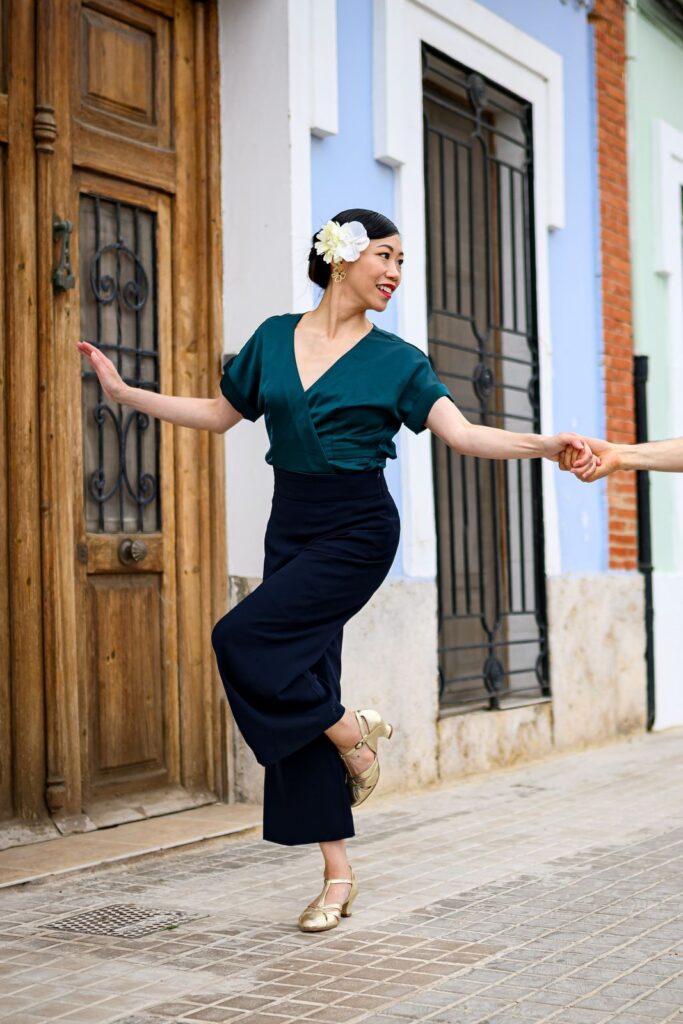
The conversation culminates in a profound truth: the interconnection of mind and body is at the heart of dance. “How we feel is very much how we carry ourselves, how we think is how we move,” suggesting a powerful feedback loop where changing one’s patterns of movement can transform one’s mental state.
This holistic philosophy signifies a paradigm shift in the perception of dance, from a mere physical activity to a deeply transformative journey of self-growth, expression, and emotional liberation. As we continue to explore these themes, it becomes clear that the path to mastering dance is strongly linked with mastering oneself.
Amy shares a pivotal experience from a Sacred Dance retreat in Sweden that reshaped her understanding of expression through dance. “It’s just freedom of expression and movement,” she explains, underscoring that Sacred or conscious dance is not about technique but about how you feel the music and move to it. “You just move how you feel,” Amy emphasizes, noting the beauty in dancers who bring nothing but their authenticity to the floor.
The experience taught her the profound visual poetry in untrained moves when they come “from the heart, from the soul.” This authentic expression, according to Amy, can often get clouded when we perform for others, losing a bit of ourselves in the process. “Sometimes if you’re doing it for someone else, it might not necessarily be coming from the soul,” she cautions, advocating for self-analysis and observation to preserve the purity of our expression.
Transitioning from the realm of freeform dance to more structured styles like Balboa or Lindy Hop, Amy touches on the importance of mastering the technique. “Practice your technique over and over again. So you get the technique down, and then you let go and you JUST DANCE,” she advises. This balance allows the dancer’s soul to accompany their movements, potentially creating a harmony that is “more visually pleasing.”
Yet, the eternal dilemma remains for many dancers – the self-critique. Amy challenges this self-judgment, and encourages you to ask yourself: “Why am I judging myself like that?” She proposes dancers step back and appreciate their unique expression, reminding us that opinions on dance aesthetics are subjective.
Diving into the essence of Swing dance, Amy highlights its foundation in improvisation and self-expression, especially in social scenarios. “It really should come from the heart because this is the heart of jazz. It’s improvisation and it’s a feeling. It’s an expression,” she asserts. Particularly for dances like slow swing, there is an abundance of space in the music that invites deep personal exploration and expression.
As we reach the conclusion of our insightful dialogue, Deirdre queries what Amy would like every dancer to take away from their conversation. In response, Amy poses a profound question: “When you come to the floor, what’s your story?” She encourages dancers to approach the dance floor with fearless authenticity, unburdened by external expectations or self-imposed limitations.
“The best dancers are the ones who let go and they just show who they are, what their opinion is,” Amy declares, championing the power of storytelling through dance. This sentiment strikes a chord with Deirdre, underscoring the shared belief in the worth of every individual’s expression.
In wrapping up, both Deirdre and Amy emphasize the beauty of creating space for oneself in dance while respecting one’s partner. This conversation, rich with personal insights and empowering advice, is an invitation for every dancer to find courage in self-expression. As Amy’s inspiring message reverberates, we are reminded to step onto the dance floor and showcase our unique stories with unabashed authenticity. So, before you take that step, remember to embrace your narrative – your dance is worth it. Go out, express yourself, and dance your story fearlessly.
Curious about Amy and want to follow her on the socials? Check out these accounts:
Geneva Swing (where Amy and Alex teach)
Amy and Alex on Instagram
Amy on Instagram
Amy and Alex on YouTube